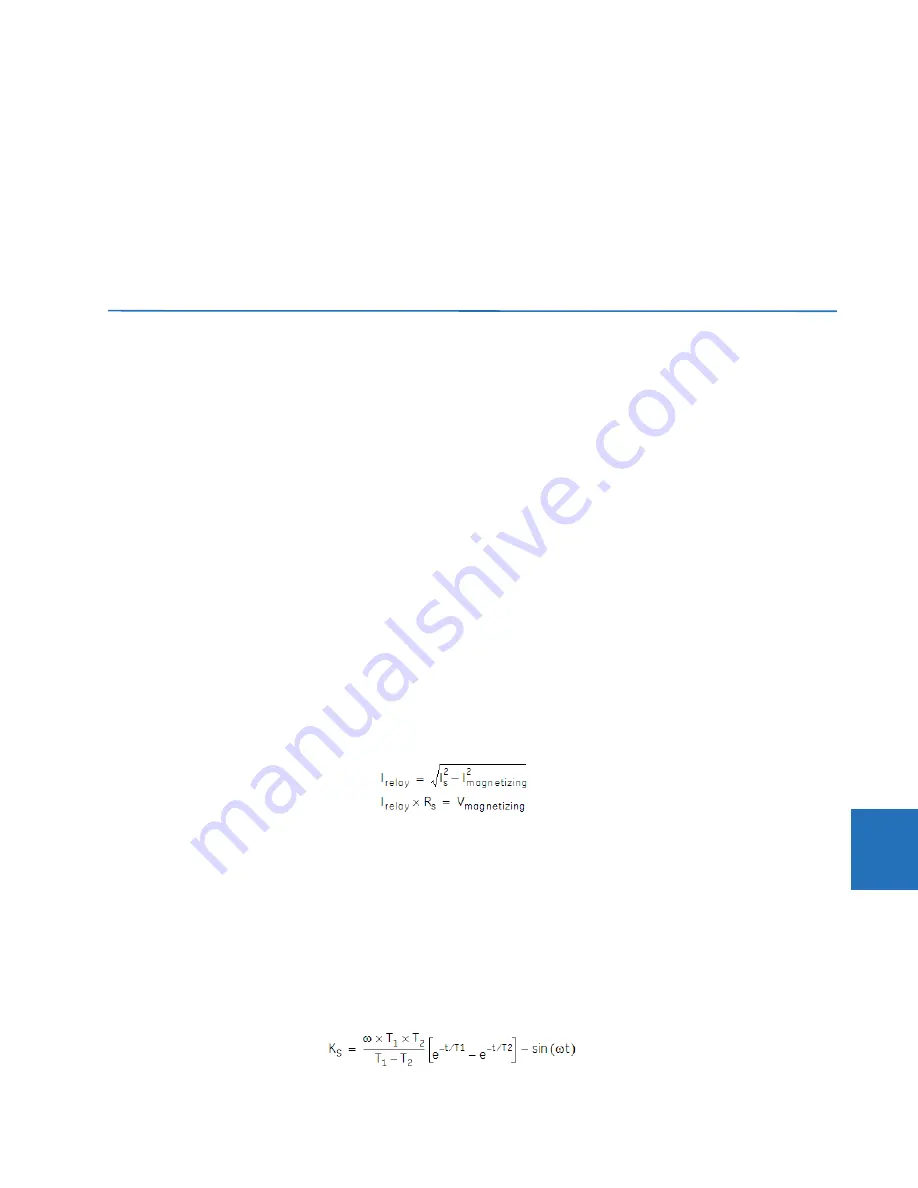
CHAPTER 8: APPLICATION OF SETTINGS
SLOPES AND HIGH SET THRESHOLD
B30 BUS DIFFERENTIAL SYSTEM – INSTRUCTION MANUAL
8-7
8
For example, if the residual flux left in the core of the CT-1 is as high as 80% of its saturation level, the CT saturates at 17.92
A secondary, or 3.58 times its rated current, or at 1.79 pu of the bus differential zone.
The reduced limit of linear operation is used as the lower breakpoint of the biased differential characteristic (the
LOW BPNT
setting). In this way the interval spanning from the lower to higher breakpoints covers the indistinct area of possible
saturation due to the random factor of residual magnetism.
The
LOW BPNT
is set at 1.79 pu for the North bus zone, and at 1.83 pu for the South bus zone.
A combination of very high residual magnetism and a DC component with a long time constant can saturate a given CT
even with the AC current below the suggested value of the lower breakpoint. The relay copes with this threat by using a 2-
out-of-2 operating mode for low differential currents.
8.4 Slopes and high set threshold
8.4.1 Description
To set the higher slope and threshold of the high set (unbiased) differential operation, external faults must be analyzed.
Consider an external fault for the North bus relay. It is justified to assume bus configurations that give maximum stress to
the maximum number of CTs. For this purpose we assume the tie breaker, B-7 closed; all the circuitry capable of supplying
the fault current to be in service; moreover, they are connected to the South bus in order to analyze the CT-7 and CT-8
carrying the fault current.
8.4.2 External faults on C-1
The following table presents the results of analysis of an external fault on circuit C-1 (C-1 is connected to the North bus; C-
3, C-4, and C-5 are connected to the South bus).
For security reasons, it has been assumed that the fault current being a sum of several contributors (C-3, C-4, and C-5 in
this case) has a time constant of the DC component of the maximum among the time constants of the contributors. The
fault current is supplied from circuits C-3, C-4, and C-5 connected to the South bus, thus through CT-3, CT-4, and CT-6. The
current passes through the tie breaker threatening saturation of CT-7 and CT-8.
By comparing the secondary currents (column 3 in the table below) with the limits of linear operation for the CTs (column 4
in the Limits of Linear Operations of the CTs table earlier), it is concluded that CT-1 will saturate during this fault, producing
a spurious differential signal for the North bus zone differential protection. All other CTs do not saturate due to the AC
components. The amount of the spurious differential current (magnetizing current of CT-1) can be calculated using the
burden, magnetizing characteristic and primary current of the noted CT by solving the following equations:
Eq. 8-4
For I
s
= 116.67 A, R
s
= 1.61
Ω
and the characteristic shown earlier in the Approximate CT Magnetizing Characteristics
figure, the solution is I
magnetizing
= 29.73 A, I
relay
= 112.8 A.
The magnetizing current of the saturated CT-1 appears to the differential element protecting the North bus as a
differential signal of 29.73 A, while the restraint signal is the maximum of the bus currents (112.8 A in this case).
Consequently, the higher slope of the characteristic should not be lower than 29.73 A / 112.8 A, or 26%, and the pickup of
the high set differential elements should not be lower than 29.73 A, or 2.97 pu.
The CTs identified as operating in the linear mode as far as the AC components are considered can, however, saturate due
to the DC components. Saturation does not occur if V
sat
> I
s
x R
s
x (1 +
ω
x T
dc
), where
ω
is radian system frequency (2
π
f).
If the above condition is violated, CT time-to-saturate for a full DC saturation can be estimated as follows. The CT
saturation factor K
s
capability curve is defined as
Eq. 8-5
Summary of Contents for b30
Page 10: ...x B30 BUS DIFFERENTIAL SYSTEM INSTRUCTION MANUAL TABLE OF CONTENTS ...
Page 486: ...5 278 B30 BUS DIFFERENTIAL SYSTEM INSTRUCTION MANUAL TESTING CHAPTER 5 SETTINGS 5 ...
Page 616: ...iv B30 BUS DIFFERENTIAL SYSTEM INSTRUCTION MANUAL ABBREVIATIONS ...
Page 632: ...xvi B30 BUS DIFFERENTIAL SYSTEM INSTRUCTION MANUAL INDEX ...







































